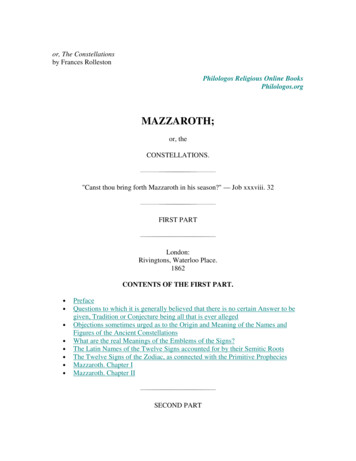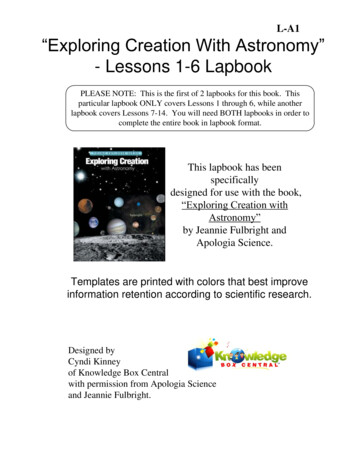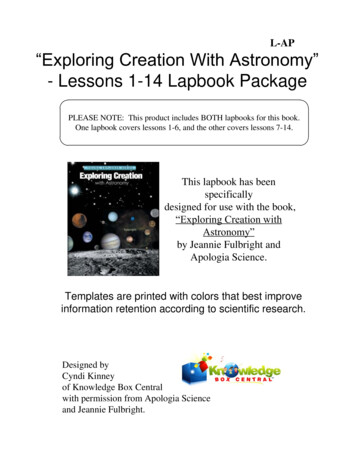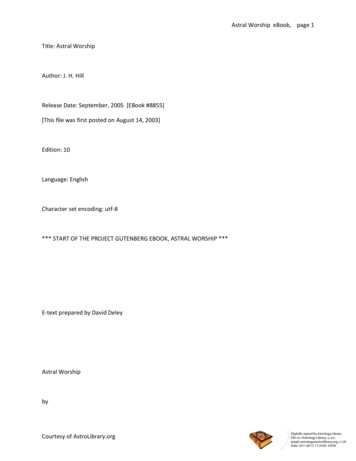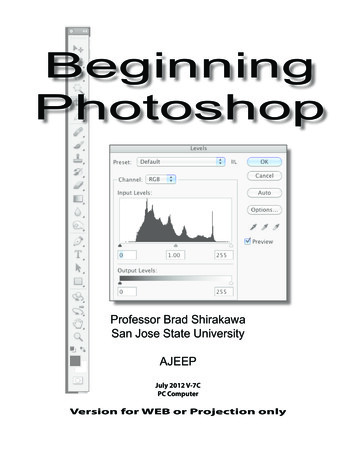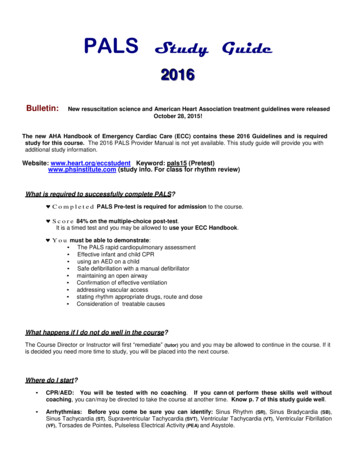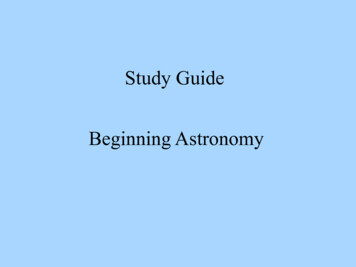
Transcription
Study GuideBeginning Astronomy
Cooler gas between the observer and a source ofcontinuous radiation gives what kind of spectrum?a. continuousb. emissionc. absorption
I came to class today because:a.b.c.d.e.It’s the right thing to do.2 or 3 clicker points will make or break my grade.I’m hiding from the police and I need an alibi.I can’t decide so I’ll answer D.Or maybe E.
As you travel southward from Canada to the UnitedStates, the Pole Star (Polaris)a. gets lower in the skyb. gets higher in the skyc. keeps the same elevation angle above the horizon
Say it is 10 AM in College Station, Texas. What timeis it in New York?a. 10 AMb. 11 AMc. 9 AMd. 8 AM
You must know these things:Earth's diameter is about 8000 milesMoon's distance is about 60 Earth radii (240,000 miles)Average distance of Earth to Sun is about 93 millionmiles (150 million km)One light-year is how far light travels in a vacuumin a year, about 6 trillion miles.“Parsec” is short for “parallax of a second of arc”1 pc 3.26 light-years. Distance in pc is the reciprocalof the parallax in arcsec (d 1/p).
The Milky Way galaxy is about 75,000 light-years indiameter. The solar system orbits the Galacticcenter at 220 km/sec on a nearly circular orbit.We are about 8000 pc (25,000 light-years) fromthe center of the Galaxy.Nearby galaxies have distances measured inmillions of light-years.The most distant galaxies we can possibly detectare at distances of about 13 billion light-years.When observing them we are looking 13 billionyears into the past.
Phases of the Moon
It takes the Moon 29.5 days to go through itscycles of phases. It just keeps orbiting the Earth,month after month after month. So if you knowwhen full moon or new moon occurs, you canfigure out approximately when the last quartermoon occurred, the next quarter moon will occur,or any other phase for that matter.If you can draw a picture of the Moon going aroundthe Earth, with the Sun off to one side, you canunderstand the phases. You don't really need tomemorize what follows on the next few slides!
The Moon goes through phases because it is basicallyspherical and the angle between the Earth, Moon,and Sun changes day to day.When the Moon is new, it is in the same direction asthe Sun, so it rises when the Sun rises and sets whenthe Sun sets.When the Moon is 50 percent illuminated and at firstquarter phase, it is one week (roughly) after new Moon.The first quarter Moon is high in the south at sunset.The first quarter Moon will set at roughly midnight.
The full Moon is full because it is on the opposite partof the sky from the Sun. The full Moon rises at sunset.The full Moon will set approximately at sunrise.A total lunar eclipse can only happen at full Moon. Atotal lunar eclipse occurs when the Moon passes intothe Earth's shadow.A third quarter Moon occurs a week after full Moon.The third quarter Moon rises roughly at midnight. Thethird quarter Moon is high in the south at sunrise.
A young crescent Moon occurs between new Moon andfirst quarter. The young crescent Moon will be visiblein the west or SW after sunset. It will set before midnight.The gibbous Moon between first quarter and full Moonis visible in the east (maybe SE) after sunset and willbe visible most of the night.The old gibbous Moon occurs between the time of fullMoon and third quarter. The old gibbous Moon willrise in mid-evening and will be visible all night.The old crescent Moon rises long after midnight. Itcan be seen in the east or southeast before sunrise.
TelescopesProbably the most important thing about a telescopeis the quality of the optics. Obviously, if the primarylight gathering element is poorly made, or thesecondary, or the eyepieces, you won't be able to domuch useful observing. Also, if your observing sitehas air pollution, light pollution, or bad seeing, thatwill seriously hamper your endeavors.But let us assume that you do have a well madetelescope at a dark site with lots of clear, steadynights. What then is important?
The most important parameter for a telescope is thelight gathering power, which is proportional to thearea of the main objective. Since it is possible tomake a mirror much larger than a lens for the sameamount of money, you can get a more powerfultelescope for your budget by investing in a reflector,as opposed to a refractor. Also, since the refractionof light is a function of wavelength, it is not possibleto make a refractor totally free of chromatic aberration.For optical viewing any telescope can get any magnificationwhatsoever, since the magnification is simply the focallength of the primary divided by the focal length of theeyepiece. For practical reasons, it is rare to be able touse more than 200X on a 6-inch to 10-inch telescope (likemost commercial telescopes).
Stars and stellar evolutionThe Hertzsprung-Russell Diagram
This is theHertzsprungRussell diagram,a plot of theluminosities ofstars vs. a measureof their temperatures. Stars at thetop of the diagramare more luminousand larger than theSun. Those at thebottom are smallerand less luminous.
The mainsequence isalso a masssequence.
More massivestars contractfaster to themain sequencein the processof formation.
Once stars haveused up theircore hydrogenthey evolve tobecome giantsor supergiants.(Well, red dwarfswith less than0.4 solar massesdo somethingelse.)
Main sequence lifetime scales with mass as follows:T* / TSun (M* / Msun)-2.5The main sequence lifetime of the Sun is 10 billionyears. A star with mass of 10 solar masses will useup its core hydrogen in 30 million years.
Starsmass 0.4 solar masses (red dwarfs), or lessnuclear energy generated mainly by: proton-proton cyclefully convective – means that they eventually convertall of their hydrogen into heliummain sequence lifetime 200 billion yearswill not become a giantcould become a helium white dwarf
Starsmass 1.0 solar masses (like the Sun)nuclear energy primarily generated by: proton-proton cyclestructure: radiative core, convective envelopemain sequence lifetime 10 billion yearsbecomes a red giant, then.end state carbon-oxygen white dwarf star
Starsmass 2.0 solar masses (like Sirius)nuclear energy principally generated by: CNO cyclestructure: convective core, radiative envelopemain sequence lifetime 1.8 billion yearsbecomes a red giant, produces a planetary nebulaeend state carbon-oxygen white dwarf star
Starsmass 8.0 solar masses or more (like Betelgeuse)nuclear energy principally generated by: CNO cycle,then in shells, then eventually they get iron coresstructure: convective core, radiative envelopemain sequence lifetime 55 million yearsbecome supergiantsend state Type II supernova -- neutron star, pulsar,or black hole
Stellar temperatures and colorsSpectral typeO9A0G2K2M5Photospheric temperature(degrees rangered
Harvard spectral classification scheme – the spectraltypes from hot to cool are OBAFGKMSpectral typeOBAFGKMspectral characteristicshelium lines, weak H linesweaker He line, stronger H linesstrongest H linesweaker H lines, some metallic linesweaker still H lines, strong lines ofcalcium, iron, sodiumeven stronger lines of Ca, Namolecular bands such as TiO, VO
Stars are fueled by nuclear fusion in their cores.Most stars spend 90 percent of their lives as mainsequence stars, converting H into He.Nuclear fission, on the other hand, is the breakingapart of heavy nuclei such as uranium.You can remember the word fusion because youknow that to fuse two objects means to stick themtogether.In their cores massive stars will successively producehelium, carbon, oxygen, neon, sodium, magnesium,oxygen, silicon, sulfur, phosphorus, nickle, up to iron.
Doppler shifts, blue shifts, red shiftsThe Doppler shift is the fractional change of thewavelengths of a source of light (or sound) comparedto the speed of the waves. For a light source withrelative velocity v along the line of sightz v/c Δλ / λIf the source's waves are shifted to shorter wavelengths,the distance between the observer and the source isdecreasing. These are blue shifts. If the distance isincreasing, the observed wavelengths are greater thanthe laboratory values. These are red shifts.
Spectral lines of starsin our galaxy are shiftedonly a little bit becausethe velocities are smallcompared to the speed oflight.The velocity of a speedingambulance can be muchlarger percentage of thespeed of sound.Distant galaxies can havevery large redshifts.
The Milky Way is a largespiral galaxy. The Sun islocated about 2/3 of the wayfrom the center to the edgeof the visible disk. TheSun is located in the planeof the Galaxy. The centerof the Galaxy is about 8000parsecs away, in the constellation Sagittarius. Thediameter of the Galaxy isabout 25,000 parsecs, orabout 75,000 light-years.The center of the globularcluster system is also thecenter of the Galaxy.
Where did various kinds of atoms come from?During the first 5 minutes after the Big Bang protons,helium nuclei, a teeny bit of deuterium and lithium,plus lots of electrons were created. 400,000 years laterthe universe was cool enough for the electrons to combinewith those protons to make neutral hydrogen atoms, andother electrons combined with the helium nuclei to makeneutral helium. Roughly 75% of the universe (by mass)was hydrogen and roughly 25% was helium.Once gas clouds collapsed into stars, nuclear fusion in thecores of stars created more helium, plus other atoms, allthe way to iron (in stars 8 solar masses or more).
Single, massive stars that blew up as Type II supernovaecreated 50% of the natural elements heavier than iron. Somost of the silver and gold in your fillings or in your jewelrywas created in some supernova explosion before theSun formed.But all the protons in the universe were created duringthe first second after the Big Bang. In fact, the temperaturewas just right to make protons and anti-protons a fewmicroseconds after the Big Bang.There is a very slight excess of matter over anti-matter,which is why there are stars and planets today.
For summary of cosmology, refer to the fullPowerpoint lecture devoted to quasars, gravitationallenses, and cosmology.
and Sun changes day to day. When the Moon is new, it is in the same direction as the Sun, so it rises when the Sun rises and sets when the Sun sets. When the Moon is 50 percent illuminated and at first quarter phase, it is one week (roughly) after new Moo
